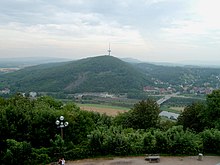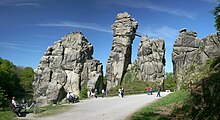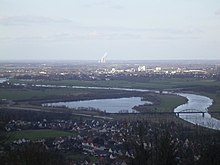List of natural units and landscapes in Ostwestfalen-Lippe


This list of the natural units and landscapes in Ostwestfalen-Lippe reflects the natural units and landscapes of a higher order insofar as they are wholly or partially in Ostwestfalen-Lippe . The division into natural spatial units results from the same abiotic factors (climate, relief, water balance, soil, geological structure) and the same biotic factors (flora and fauna). From an ecological point of view, a landscape is a geographical area which is distinguished from other areas by different characteristics. In contrast to the natural spatial structure, this can also include culturally determined factors.
Natural units
Outline scheme
Greater region (e.g. German low mountain range *)
- xy main unit group (e.g. 36 Upper Weserbergland)
- xyz main unit (e.g. 364 Lipper Bergland)
→ For further explanation see: List of the natural units in North Rhine-Westphalia
list
The basic natural units are:
German low mountain range threshold *:
33 Bergisch-Sauerland Mountains or Southern Mountains
- 360 Warburger Börde
- 361 Oberwälder Land
- 362 Paderborn plateau
- 363 Egge (mountains)
- 364 Lipper Bergland
- 365 Pyrmonter Bergland *
- 366 Rinteln-Hamelin Weserland *
- 367 Holzmindener Wesertal *
37 Weser-Leine-Bergland *
- 378 Calenberger Bergland *
- 530 Bielefelder Osning (eastern Teutoburg Forest )
- 531 Ravensberger Mulde
- 532 Eastern Wiehengebirge , (also a small part of the Western Wiehengebirge)
- 533 Lübbecker Loessland
- 540 Ostmünsterland ( Ems sand plain ) *
- 542 Hellwegbörden *
58 Dümmer-Geest Basin *
- 582 Rahden-Diepenauer Geest
- 583 Middle Weser Valley *
- 584 Diepholzer Moorniederung *
- 628 Loccumer Geest *
Most of the units marked with * are not located in Ostwestfalen-Lippe.
Landscapes
Ostwestfalen-Lippe includes the following landscapes :
Most of the landscapes marked with * are not located in Ostwestfalen-Lippe.
Historical-cultural sub-regions
Alternatively, for historical reasons, people feel they belong to the following historically and culturally based sub-regions:
- Minden-Ravensberg : predominantly Lutheran and early Prussian areas in the north
- Hochstift Paderborn : predominantly Catholic areas in the diocese of Paderborn in the south
- Lippe : Area of the former state of Lippe with a long independent history
See also
literature
- Emil Meynen (Hrsg.): Handbook of the natural spatial structure of Germany. Self-published by the Federal Institute for Regional Studies, Remagen 1953–1962 (Part 1, contains deliveries 1–5).
- Emil Meynen (Hrsg.): Handbook of the natural spatial structure of Germany. Self-published by the Federal Institute for Regional Studies, Remagen 1959–1962 (Part 2, contains delivery 6–9).
Web links
- Phenological natural space map
- Map of the natural spatial landscape according to BfN
- Wolfgang Dinter (LÖBF): Natural Spatial Structure NRW (PDF file; 252 kB)
Coordinates: 51 ° 56 '30.2 " N , 8 ° 31' 53.7" E







